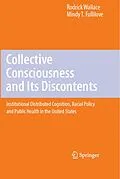This book expands a recent mathematical treatment of the Baars model of individual consciousness to an institutional venue in which multiple 'Global Workspaces' cooperate, communicate, and compete. The result is an expansion of Dretske's necessary conditions communications theory approach to high level cognition, having potential applications ranging from the organizational ecology of the firm to the design and analysis of highly parallel or networked autonomic computing systems. The particular example explored in detail, the failure of AIDS control and treatment in the United States, generalizes distributed cognition approaches to medical error and applies them to larger scale patterns of failure in public health, affecting populations rather than individuals. The book is written as a series of nearly independent chapters, and can be read at markedly different mathematical levels.
Zusammenfassung
An earlier book by Rodrick Wallace entitled Consciousness: A Mathematical Treatment of the Global Neuronal Workspace Model, introduced a formal information-theoretic approach to individual consciousness implementing approaches developed previously by the cognitive scientist Bernard Baars and the philosopher Fred Dretske.
This book takes a more formal 'groupoid' perspective and generalizes the results of that book to processes of 'distributed cognition' characteristic of large institutions that can entertain several, sometimes many, simultaneous 'global workspaces' which must compete for resources while communicating and cooperating.
Equivalence classes of 'states' produce a network of language-analogs characterizing interacting cognitive modules which entertain multiple workspaces. Equivalence classes of these language-analogs produce dynamical manifolds describing temporal processes carried out by multiple-workspace institutions.
Inhalt
Consciousness And Distributed Cognition.- Formal Theory.- Pathologies Of Collective Consciousness.- Disease And Collective Consciousness.- The Failure Of Aids Control And Treatment In The Us.- Final Remarks.- Mathematical appendix.- References.
